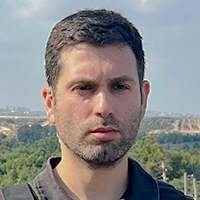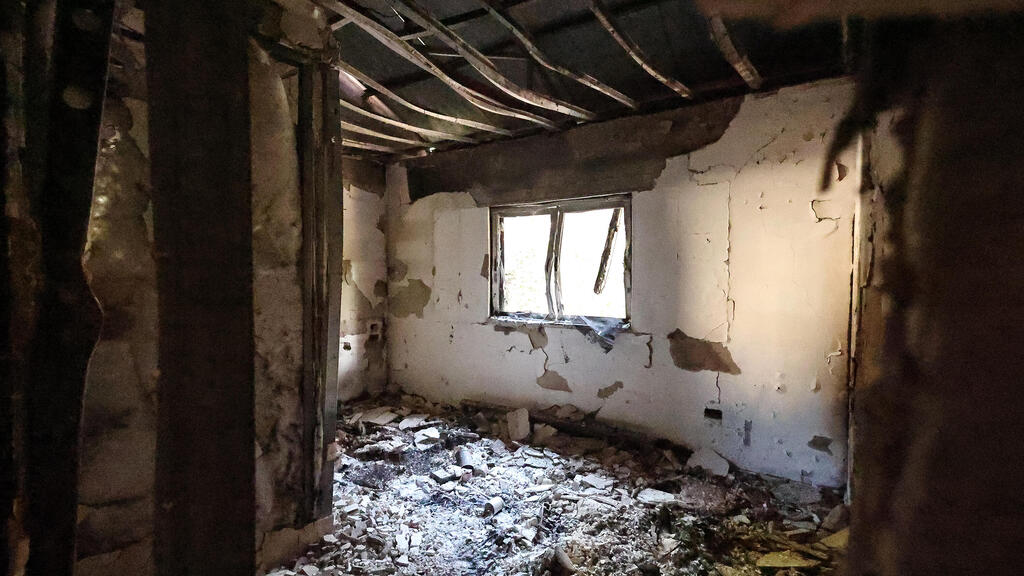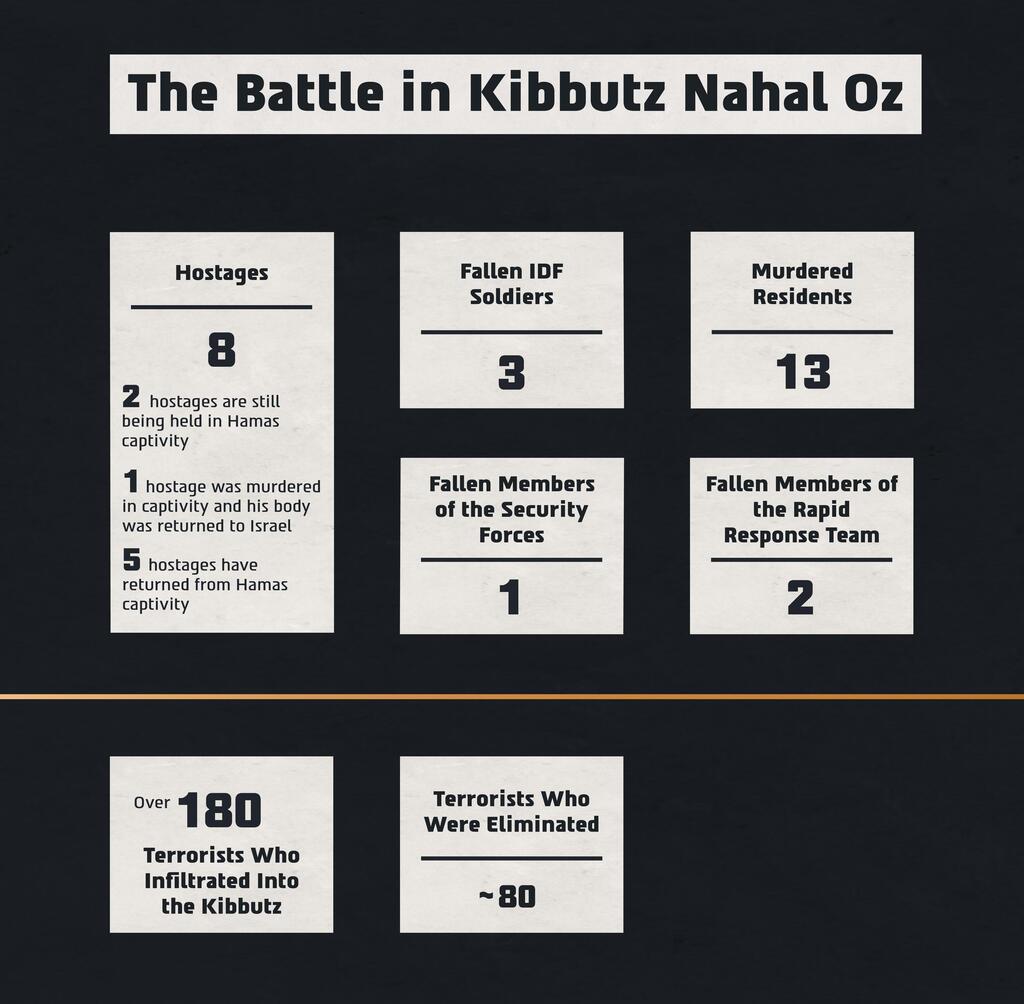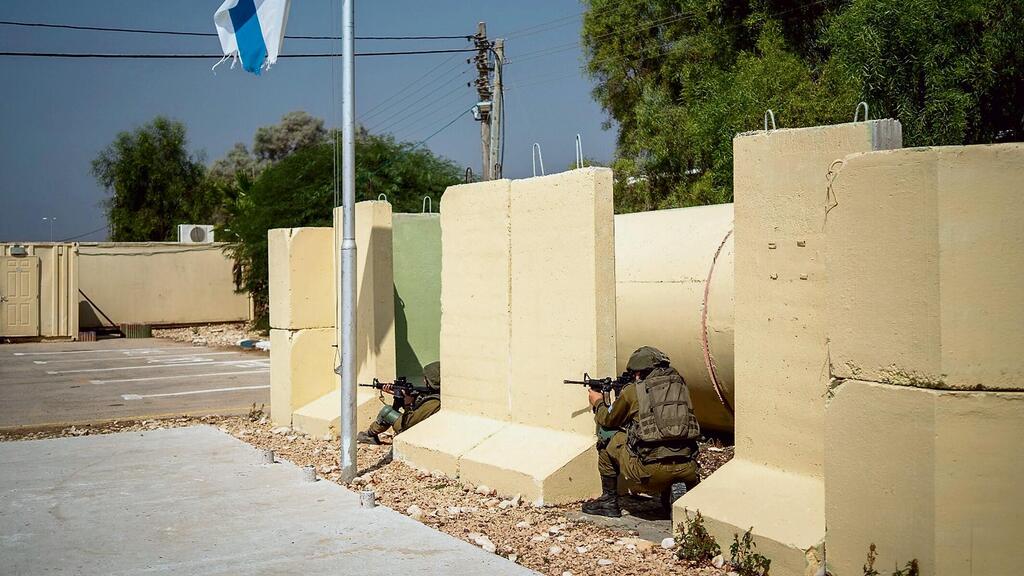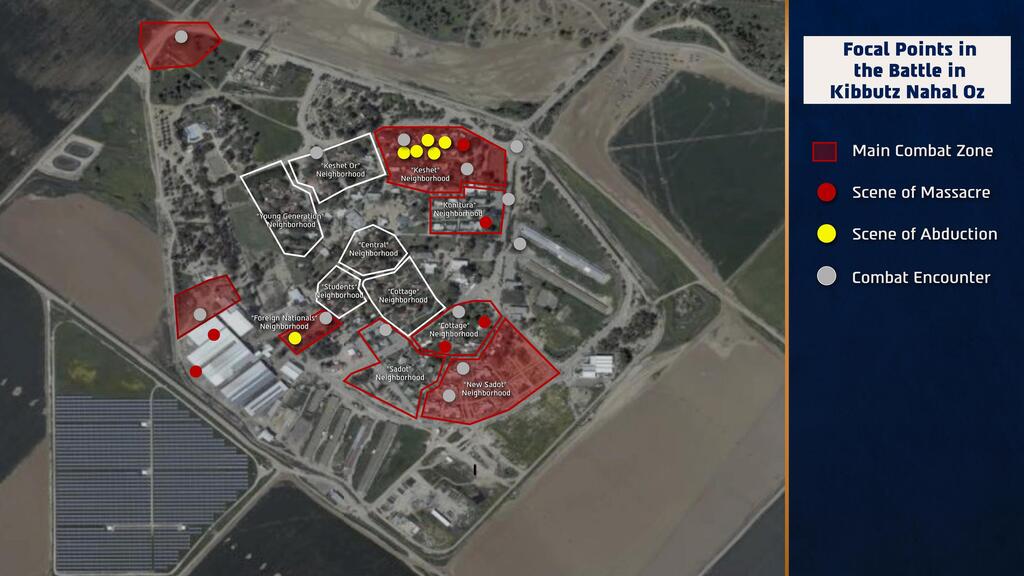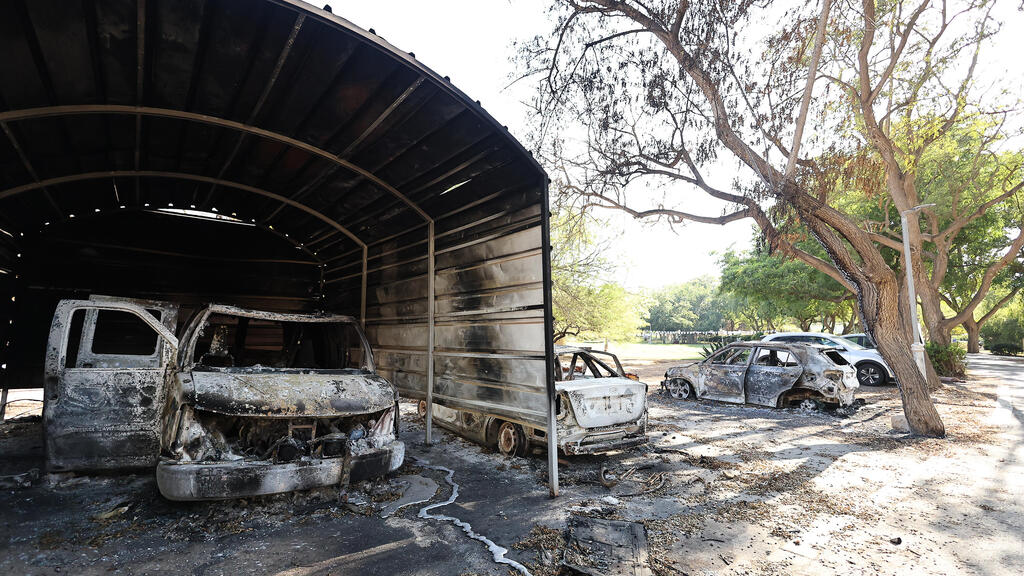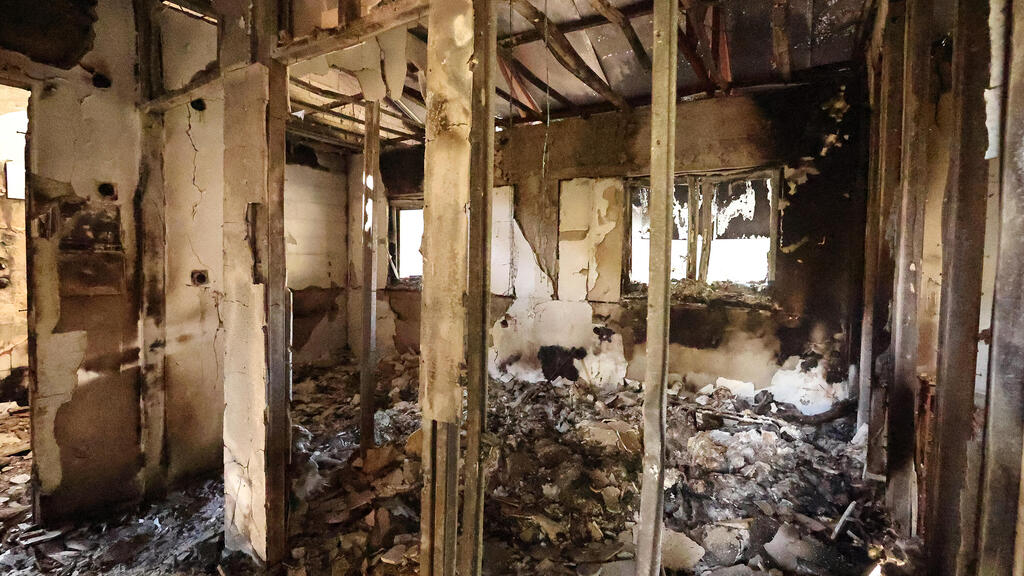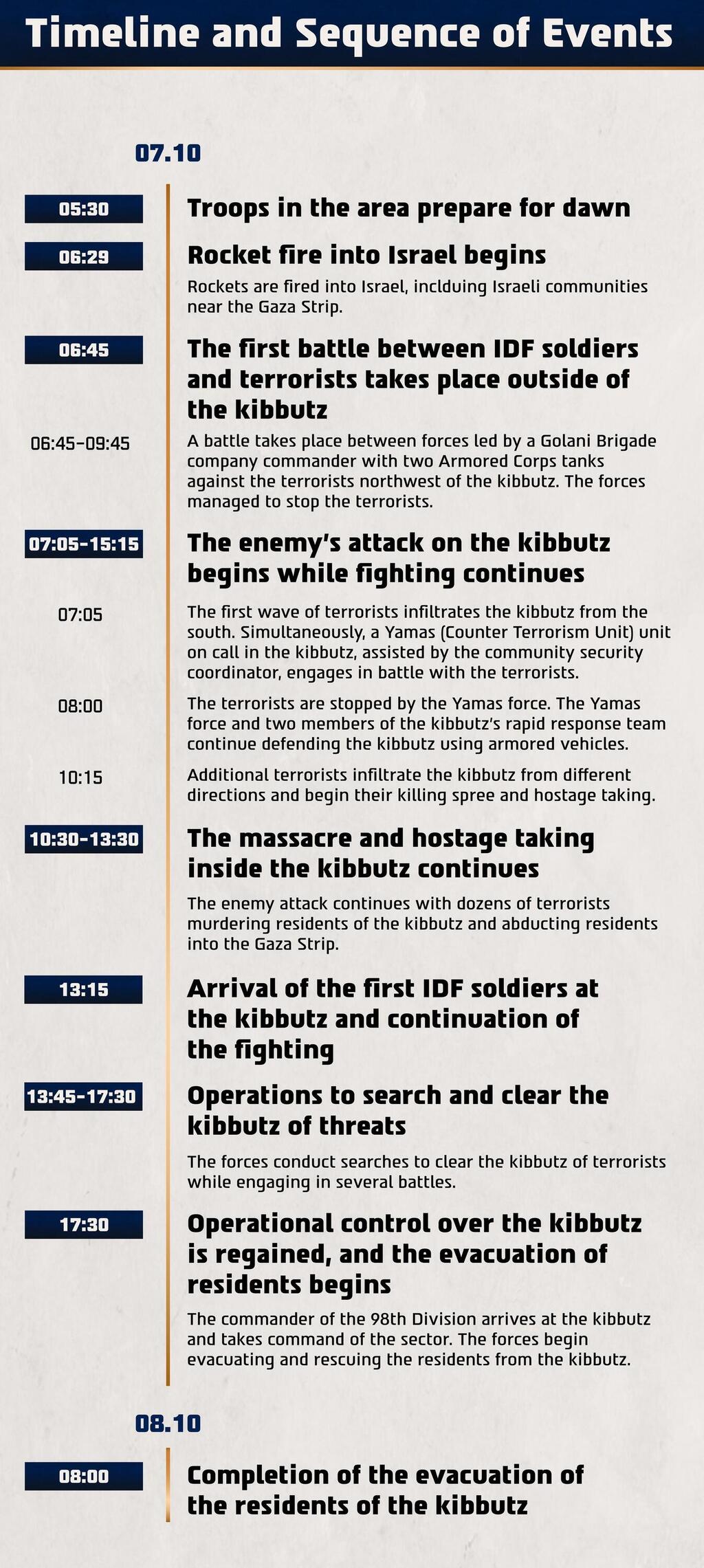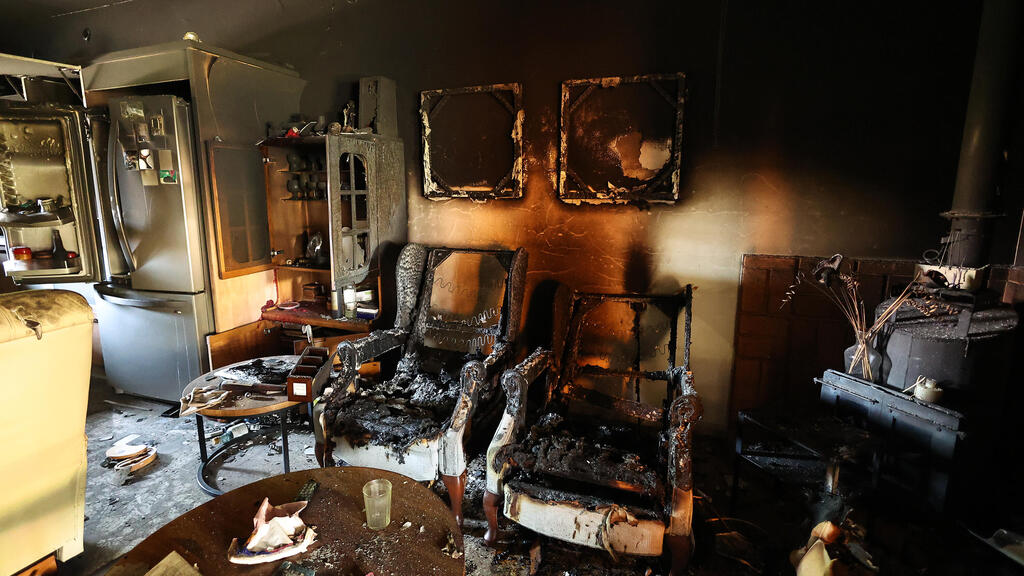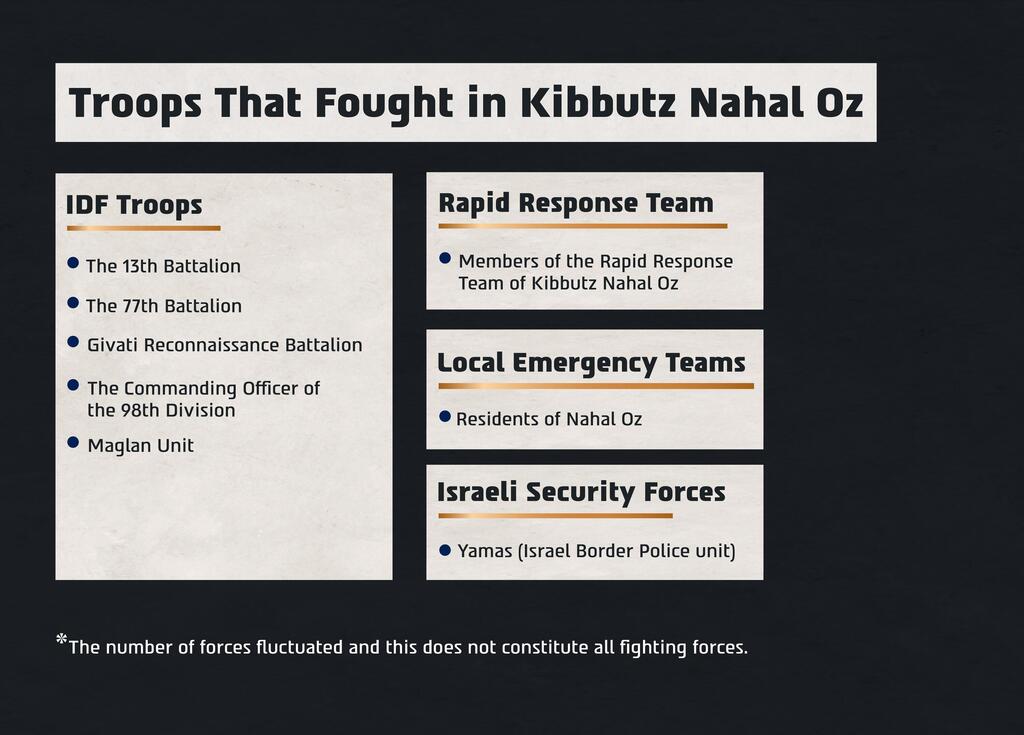Getting your Trinity Audio player ready...
A small team from the undercover counterterrorism unit, stationed at Kibbutz Nahal Oz as part of preparations for border protests, played a key role in preventing a large-scale massacre on October 7, 2023.
The kibbutz, located just a few hundred yards from the Gaza border, faced a deadly infiltration by Hamas terrorists. However, reinforcements from the IDF’s Maglan unit were delayed after encountering a deadly ambush in a nearby forest. By the time they reached the kibbutz at midday, the counterterrorism officers and local alert squad were already overwhelmed, and the toll was devastating.
According to an IDF investigation published Tuesday, the first wave of infiltrators from Gaza was repelled through extraordinary bravery and professional skill, with a handful of fighters holding off dozens of terrorists. However, the second wave, which arrived around noon, carried out a massacre and kidnappings. The report also revealed that, in the aftermath of the battle, three kibbutz residents were mistakenly killed by Israeli forces.
The findings highlight a severe intelligence failure by Unit 8200 and other surveillance systems within the IDF, police and Shin Bet, which even Hamas had expected to be operational. One Hamas terror cell that entered the kibbutz used 17-year-old resident Tomer Eliaz-Arava as a human shield, forcing him to convince residents hiding in their reinforced safe rooms to come out and surrender. The terrorists also broadcast their demands live on Facebook using his mother’s account, calling for an end to Israeli airstrikes.
Realizing that no one in Israel’s security apparatus was monitoring the live broadcast, the terrorists switched to another Facebook Live feed using the phone of another kibbutz resident. However, this too went unnoticed by any command center, police operations room or intelligence unit.
Nahal Oz is one of the three most vulnerable border communities in the Gaza border region. However, unlike conflict-prone areas in the West Bank, the kibbutz’s security cameras were not funded by the Defense Ministry — despite their critical role in defense. The investigation found that on the morning of October 7, power outages rendered the cameras inoperable. Any attempt by the kibbutz to install a backup generator or repair the system would have required funding from the regional council’s municipal budget — effectively equating the residents’ security needs with basic public services like garbage collection.
Over the course of the massacre, 15 Israeli civilians were murdered in Nahal Oz, and eight others were taken hostage to Gaza. Five of them have since been released alive. Four security personnel were also killed.
On the holiday of Simchat Torah, 450 people were in Nahal Oz, which is located near two military outposts intended to protect it: Camp Nahal Oz, just 300 yards away, and Outpost Pega, about two miles away. Another base, Magen Alumim, which housed a battalion reserve force, was also within the kibbutz’s security sector.
The investigation revealed that a small IDF force, including a tank and a Golani company commander, arrived at Nahal Oz relatively quickly — within 15 minutes of the attack’s start — blocking a major infiltration route. However, the first wave of 40 Hamas terrorists from the elite Nukhba force breached the kibbutz from another direction, entering through the back gate. Around 10:00 a.m., another 60 terrorists from Gaza City’s Shati neighborhood joined them as part of the second wave.
At the time of the attack, Nahal Oz had 16 members in its local alert squad, but only four were armed. The community’s armory could not be opened due to the power outage, and only the local security coordinator, Ilan Fiorentino — who was killed early in the attack after saving a teenager out for a morning run — knew the access code.
"There was no clear directive to keep weapons stored in home safes rather than in the armory," the investigation found. "It was a disorganized policy set by the division and northern brigade."
The attack on Kibbutz Nahal Oz – minute by minute
6:45 a.m.: Security coordinator Ilan Fiorentino reports a power outage in the kibbutz to the Northern Brigade. He activates an undercover police counterterrorism unit that was on standby for expected border protests. The unit consists of 11 officers from the Jerusalem District Yamas tactical unit, equipped with two heavily armored Wolf vehicles. Meanwhile, Fiorentino spots 13-year-old Ariel, who was out for a morning run. He picks him up, drives him to a safe room in one of the kibbutz homes, and saves his life.
6:46 a.m.: A small Golani and Armored Corps force, led by Lt. Daniel Perez, engages dozens of Hamas terrorists attempting to breach the kibbutz from the main gate. They manage to block the advance, but other attackers infiltrate from the rear entrance, where they are met by the undercover unit and four alert squad members. Three Israelis are killed in this first wave, but the small defending force prevents the kibbutz from being overrun.
6:50 a.m.: The undercover police team, led by First Sgt. Yaakov Shlomo Krasniansky, quickly engages the terrorists, killing many of the attackers.
7:12 a.m.: Fiorentino and three alert squad members fight Hamas terrorists at multiple locations within the kibbutz, preventing further infiltration. Fiorentino is killed in close combat.
7:20 a.m.: Krasniansky and his team push back the Nukhba unit, which is still attempting to enter homes. Just as they are about to gain full control, Krasniansky is killed in a final charge against the terrorists. Four of his men are wounded.
7:25 a.m.: Roy Revivo, a former police officer, hears a terrorist outside his home. He leaves his family inside the safe room and goes out armed with his pistol.
7:30 a.m.: Relative calm is restored in Nahal Oz after the undercover police unit kills around 30 terrorists in 40 minutes, preventing a larger massacre with the help of a small number of local emergency responders. However, some Hamas fighters remain in the kibbutz.
8:40 a.m.: Reinforcements fail to arrive, leaving residents to tend to the wounded themselves. Ruti Wagner shelters and cares for eight injured people in her home until 1:15 p.m.
8:45 a.m.: The undercover unit repeatedly requests reinforcements from the Northern Brigade and Gaza Division, fearing a second wave of attackers.
9:02 a.m.: At the request of Lt. Perez, an attack helicopter fires at a swarm of terrorists moving from Gaza toward Nahal Oz and Kfar Aza.
9:20 a.m.: Less than an hour before the arrival of the second wave of terrorists, a few remaining infiltrators from the first wave target homes of elderly residents, murdering Shlomo Ron and Haim Livne in cold blood.
10:00 a.m.: The second wave of Hamas terrorists, arriving from Gaza City’s Shati neighborhood, storms the kibbutz, unleashing a campaign of murder, looting and kidnapping. By 11:00 a.m., 180 terrorists are in the kibbutz, facing only eight remaining defenders after the Armored Corps and Golani forces had moved on to battles at Nahal Oz base and Kfar Aza, and four Yamas Israel Border Police unit fighters had been evacuated with serious injuries.
10:40 a.m.: A Nukhba squad from the second wave enters the Eliaz-Arava family home and begins a live broadcast on Facebook using the account of Dikla Eliaz-Arava. Her partner, Noam, is shot in the leg. The terrorists demand that Israeli airstrikes in the area stop, but no IDF, police or Shin Bet operations center is monitoring the broadcast. Noam pleads for them to take him hostage instead of his children — but is executed.
10:50 a.m.: The terrorists take 17-year-old Tomer Eliaz-Arava from his home, forcing him to convince his neighbors to surrender and leave their locked safe rooms. The event is broadcast live on Facebook, but no security forces are watching. Tomer remains calm, reassures his neighbors and tries to signal distress through the broadcast, but his plea goes unnoticed.
10:52 a.m.: A police intelligence officer in the kibbutz attempts to guide an Apache attack helicopter toward a group of terrorists preparing for the second assault near the kibbutz gate. However, a miscommunication leads the helicopter crew to believe the target is two moving vehicles containing security forces. Unwilling to take the risk, the pilots fire a "disruption strike" near the vehicles instead. The explosion startles the terrorists, who flee—only to return two minutes later.
Get the Ynetnews app on your smartphone: Google Play: https://bit.ly/4eJ37pE | Apple App Store: https://bit.ly/3ZL7iNv
10:58 a.m.: Dozens of terrorists storm the foreign workers’ housing, unleashing chaos, terror and brutal executions. The attackers film themselves attempting to behead a Thai worker with a hoe while he is still alive. Failing to do so, they shoot him at point-blank range. Elsewhere, they capture a Tanzanian student, mistakenly believing he is an Ethiopian Israeli. His desperate pleas fail, and another group of terrorists demands custody of him. A violent dispute erupts between the two Hamas groups, which ends when one terrorist executes him with a bullet to the head
11:00 a.m.: A Nukhba squad attempts to storm the Levi family home, where M., a former police special forces officer now working as the kibbutz landscaper, is holed up. Armed with 10 magazines he had prepared for an emergency, he eliminates nearly every terrorist who approaches, firing through windows and doors.
11:10 a.m.: Realizing that no one in the IDF is monitoring their Facebook Live broadcast from Dikla Eliaz-Arava’s phone, the terrorists attempt to stream from another resident’s phone—but again, no one is watching.
11:20 a.m.: As Tomer Eliaz-Arava is being forced at gunpoint to go house to house, his family is abducted in a Hyundai SUV that arrived from Gaza. A soldier spots the vehicle near the kibbutz dairy farm and opens fire, unaware that hostages are inside. Dikla is killed instantly, while her wounded husband, Noam, tries to escape but is shot dead by terrorists. Their daughters, Dafna and Ella, are kidnapped and later seen in Gaza in footage from the Strip.
11:30 a.m.: The only substantial remaining defense force in the kibbutz consists of seven undercover officers in a single armored Wolf vehicle. The unit’s two other vehicles had already evacuated the wounded. The team patrols the kibbutz, engaging terrorists wherever they can, firing through the vehicle’s riot-control gun ports. At one point, they are hit by an anti-tank missile but continue driving, despite heavy damage.
12:00 p.m.: A reinforcement unit—a light Jeep Wrangler carrying five Maglan soldiers, led by Maj. Chen Bouchris—encounters a Hamas ambush in a wooded area near the kibbutz. Bouchris and two soldiers are killed in the ensuing gunfire. The two surviving soldiers continue fighting and radio for backup.
12:30 p.m.: The terrorists holding Tomer Eliaz-Arava arrive at the Zohar family home, but the situation takes a tragic turn. The family of four had survived thus far thanks to a deadbolt that father Yaniv had installed inside their reinforced safe room. After two hours of silence, they step outside—just as the terrorists arrive. The attackers open fire, killing all four.
12:35 p.m.: After two hours of being forced to accompany the terrorists, Tomer Eliaz-Arava realizes they are no longer taking hostages—but executing them. After witnessing the Zohar family’s murder, he makes a desperate run for the dairy farm. He is shot dead on the spot, likely by Israeli forces who mistakenly believe he is a terrorist.
1:00 p.m.: Terrorists attempt to abduct an entire family in their own vehicle, but the car stalls within the kibbutz. They then drag one of the family members toward Gaza on foot, taking her across the border into captivity.
1:15 p.m.: A second Maglan force of 70 soldiers arrives, advancing through the fields to avoid ambushes. As they enter the kibbutz, the last known hostage abduction takes place via the rear gate.
1:30 p.m.: Another Maglan unit arrives, accompanied by Maj. Gen. (res.) Noam Tibon, who drove from his home in Tel Aviv in his private car to rescue his son, Amir, and his grandchildren. On his way, Tibon stops near Kibbutz Mefalsim to assist wounded soldiers. He leaves his wife, Gali, behind to help evacuate the injured and continues toward Nahal Oz, joining a crowded military vehicle. A wounded Yamam counterterrorism officer, who refuses to evacuate, also joins the force. Near the kibbutz, Tibon, 63, drops his personal handgun and picks up the weapon of fallen Maj. Chen Bouchris to engage in combat.
1:40 p.m.: The force enters the kibbutz, eliminating remaining terrorists and securing the area. Tibon leads the effort to evacuate the wounded from the ambush site, transporting them to where his wife, Gali, is stationed near Mefalsim. There, he meets Maj. Gen. (res.) Israel Ziv and a Givati reconnaissance unit. The two former generals join the Givati fighters on their return to Nahal Oz.
2:30 p.m.: A tragic friendly fire incident unfolds, marking the third such incident in two hours. A Givati reconnaissance team is ordered to hold position near a gate for evacuation operations. However, an unauthorized group joins them, including an officer, a cadet, and a man from Netivot who claimed to be a former Yamas officer, wearing a police cap and civilian clothes. Against orders, the group begins clearing buildings. Spotting movement on the second floor of a house, they suspect a terrorist is inside and request permission to fire. The "security officer" from Netivot opens fire, killing 48-year-old Ran Poslushni, a local alert squad member who had been fighting terrorists all morning with his soldier son’s weapon.
3:00 p.m.: Tibon takes part in clearing operations and, for the first time that day, reaches his son Amir’s home in the kibbutz.
3:30 p.m.: The final engagement in Nahal Oz takes place, with one last terrorist killed after dozens of others had fled back to Gaza.
6:30 p.m. – 8:00 a.m. (next morning): Residents are evacuated to the Mishmar HaNegev military base, before being relocated to Kibbutz Mishmar HaEmek.
The failures of the Northern Brigade
Despite being vastly outnumbered and caught by surprise, the small defending forces in Nahal Oz successfully repelled Hamas’ first assault on October 7, demonstrating exceptional courage and skill. However, for three critical hours, reinforcements failed to arrive, command coordination was ineffective and the second wave of terrorists — responsible for most of the massacres and abductions — was able to advance unchallenged.
The battalion reserve force was diverted to Kfar Aza, where it proved too weak, undersized and poorly equipped due to decisions made at the regional brigade and divisional command levels. The investigation found that the Gaza Division and Northern Brigade lacked any reserve force, a fundamental failure in defensive planning.
Col. Haim Cohen, commander of the Gaza Division’s Northern Brigade, who remains in his position despite multiple command failures identified in previous investigations, stayed in the division’s command center rather than positioning himself closer to the battle, failing to provide an accurate assessment of the situation in Nahal Oz. A whiteboard in his office incorrectly listed elite units such as Sayeret Matkal, Yamam and Shayetet 13 as being deployed in the kibbutz, creating a false operational picture detached from reality.
According to the investigation, Cohen should have set up a forward command post in the field, in line with standard defensive doctrine for surprise attacks. The original plan called for a command post near Mavki'im north of Gaza, but given the unfolding disaster, it should have been relocated to Sa’ad Junction — a key intersection in northern Gaza border communities, linking Sderot, Kfar Aza, Nahal Oz, Re’im and southern battle zones.
Throughout the morning and early afternoon, thousands of soldiers and officers rushed from their homes to join the fight, arriving at Sa’ad Junction hoping for orders. However, brigade and division commanders lost control, leaving many to self-deploy into scattered battle zones without clear direction.
The investigation also revealed critical intelligence failures, including the brigade’s unawareness that Nahal Oz’s emergency weapons were locked in an armory instead of being stored in responders' homes, severely hampering defense efforts.
Despite these failures, the report praised the bravery of several key figures who played a decisive role in preventing an even greater tragedy:
First Sgt. Yaakov Krasniansky (killed in action), whose undercover police team held back dozens of terrorists; security coordinator Ilan Fiorentino (killed in action), who saved lives and fought to defend the kibbutz; and Maj. Gen. (res.) Noam Tibon and his wife, Gali, who, while en route to rescue their son, joined the fight and assisted in life-saving evacuations.



